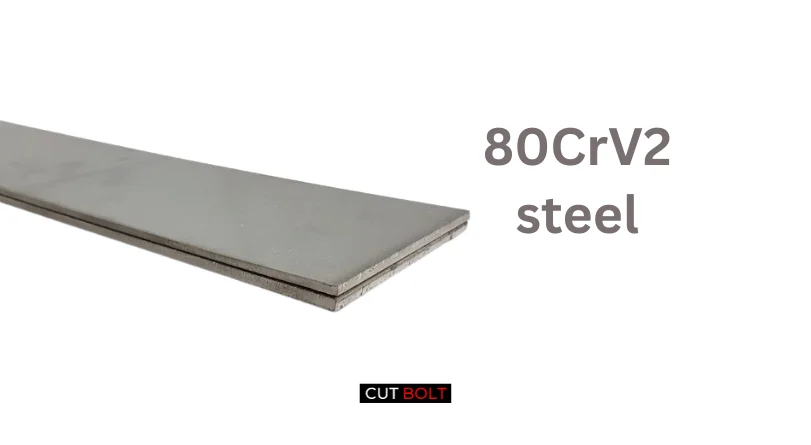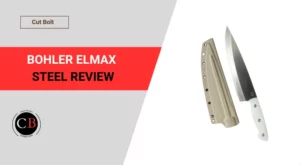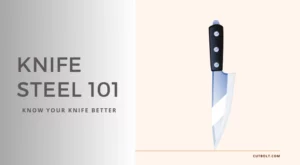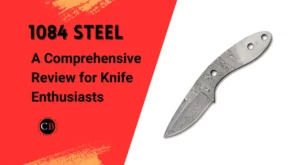Steels are like knives – there seems to be an almost infinite number of them. And whenever you think you’ve finally gained an overview, you stumble across another interesting steel that you didn’t know till now.
That’s how I felt about the 80CrV2 steel, and I don’t think I’m alone. So I sat down and did some research.
First of all, the market for mass-produced knives made from this steel seems to be small or non-existent, but it is very popular among knifemakers and those who want to become knifemakers.
So what is this steel all about? What is its chemical composition, its hardness and all the other properties that interest us knife enthusiasts? That’s what this article is all about.
Table of Contents
What is 80CrV2 steel?
It is a manganese-vanadium steel with a carbon content of 0.8%, which makes it a true high carbon steel; as such, it is easily hardenable and has very good cutting ability.
It has an excellent reputation for toughness and impact resistance, comparable to S7 steel. It is used by companies such as Zombie Tools and Winkler Knives.
80CrV2 steel is commonly known as Swedish saw steel and is comparable to S7 steel. Specifically, 80CrV2 is a low-alloy carbon steel that has better tensile strength and quenching properties than plain carbon steels.
It has a relatively high carbon content and can achieve good hardness levels. Therefore, its name 80CrV2 comes from the high concentration of the elements carbon, C (0.85), chromium, Cr (0.60), and vanadium, V (0.25).
This mixture of elements gives it high toughness and good cutting resistance. Because of this resistance, especially its ability to withstand impacts, it is often used to make blades that are subjected to difficult working conditions, such as hand saws and loppers, which require high strength.
80CrV2 is ideal for outdoor and utility blades. It is often used in Northern Europe to make puukos, a popular simple and sturdy utility knife. The steel is usually delivered hot rolled and annealed.

Who produces 80CrV2 steel?
Contrary to popular belief, this is probably not another Chinese steel, but a German product. See here. The statement should be taken with a grain of salt, however, as no specific manufacturer is named. However, zknives also speaks of a “European steel”, see here.
Other designations and standards of 80CrV2 steel
EN 80CrV2 steel is alternatively also available under these designations:
| Standard | Proprietor |
|---|---|
| AFNOR 100C3* | Allegheny Ludlum – Caroga |
| AFNOR 55CNDV4 | Allegheny Ludlum – Albany |
| AISI L2 | Bestar BE2235 |
| CSN 19422* | Bethlehem Tough-M |
| CSN 19421* | Bohler-Uddeholm B400 |
| CSN 19419 | Columbia Steel – Columbia L-2 |
| DIN 115CrV3* | Crucible Halvan |
| DIN 80CrV2 | Edelstahl Witten-Krefeld – Thyrodur2235 |
| DIN 80CrV2* | Eschmann-Stahl – CRV Silver Steel |
| EN 107CrV3* | Firth-Sterling – Demmler-D |
| GOST KH1F | Houghton & Richards – H&R No.15 |
| GOST X1F | Houghton & Richards – H&R No.44 |
| GOST 11X | Jessop Steel – ET6 |
| GOST 11XF | Latrobe – E #6 |
| GOST 11KH | Latrobe – Superb |
| GOST 11KHF | Latrobe –Crown Superb |
| GOST 9KHF* | Metal Ravne – OL2SP |
| JUS C.4141* | Ossenberg – ON22 |
| JUS C.4844 | Poldi – DS Special* |
| PN NW1 | Sanderson Kayser – KE896 |
| UNE 120CrV | Thyssen-Krupp – 2210 |
| UNI 107CrV3KU* | Trinec – T75CV |
| UNS T61202 | Universal Cyclops – Orion |
| W-Nr 1.2235* | Universal Cyclops – Cyclops L2 |
| W-Nr 1.2235 | Vanadium Alloys – Vanadium Type Auto |
| W-Nr 1.2210* | Vasco Metal – Vanadium Type H |
| Zapp – VC5 | |
| Ziv Steel – Zivan 45 |
* listed as an equivalent or replacement for alloys in this group.
NOTE: Approximate composition based on manufacturer or standard reference information and other alloys in the same reference group are provided.

Chemical composition of 80CrV2 steel
80CrV2 has a high carbon content (0.85%), making it a high carbon steel. It also contains a mixture of various other elements that shape its properties:
| Element | Portion | Effect |
| Chrome | 0.40 – 1.20% | Improves wear resistance, heat resistance and scale resistance. It increases tensile strength because it acts as a carbide former. Use of rust-proof or stainless steel, as it increases corrosion resistance from a mass proportion of 12.2%. Reduction in weldability. |
| Carbon | 0.45 – 1.00% | Increasing hardness and tensile strength. In larger quantities, increase in brittleness and reduction in forgeability and weldability. |
| Copper | 0.00 – 0.25% | Improving weather resistance (surface oxidation). |
| Mangan | 0.10 – 0.90% | Improves hardness and tensile strength. |
| molybdenum | 0,18 – 0.25% | Improves hardenability, tensile strength and weldability. Reduction in forgeability and ductility. |
| Nickel | 0.00 – 0.40% | Nickel increases tensile strength and yield strength. From 8% increase in corrosion resistance. |
| Phosphor | 0.025 – 0.03% | Increases tensile strength, hardness and corrosion resistance but also brittleness. |
| Sulfur | 0.025 – 0.03% | Increases machinability but also brittleness. |
| Silicon | 0.10– 0.50% | Improves strength. |
| Vanadium | 0.10 – 0.30% | Increasing hardness, increasing wear resistance and improving tempering resistance. |

What is the hardness (HRC) of 80CrV2 steel?
80CrV2 steel can reach a maximum hardness of 57-58 HRC and is therefore a hard but not extremely hard steel. However, it can happen that you find different Rockwell hardness values to this steel. This is because the hardness can vary depending on how it is heat treated.
At 57-58 HRC, 80CrV2 is far from the hardest knife steel on the market, but it is still in a good range to provide a knife blade with high wear resistance and good edge retention.
Is 80CrV2 rustproof or high-grade steel?
80CrV2 steel is neither rustproof nor, strictly speaking, stainless steel, depending on the manufacturer and varying composition. To be considered stainless, it would need a chromium content of at least 10.5 – 13% dissolved in austenite or ferrite, depending on the definition (see here), and to be stainless steel, its sulfur and phosphorus content (so-called iron companion) must not exceed 0.025% (see here).
Properties of 80CrV2 steel
The study of the properties of a steel provides information about the performance blade and whether it meets the desired requirements. According to the chemical composition and hardness of 80CrV2, it offers the following properties and characteristics:
1. Edge retention
The ability of steel to maintain its sharpness for a long time has a lot to do with its hardness. A blade made of 80CrV2 steel holds its sharpness well, provided that the heat treatment was appropriate.
2. Corrosion resistance
80CrV2 has a comparatively very low chromium content of 0.6%, which makes the steel susceptible to corrosion. It is not a steel that should be used in humid and corrosive environments.
However, rust can be prevented through proper rust prevention measures such as regular cleaning and oiling of the blade, especially after contact with moisture. In addition, manufacturers are now coating their 80CrV2 blades with anti-rust coatings that go a long way toward preventing rusting of an 80CrV2 knife.
3. Wear resistance
80CrV2 offers average wear resistance due to the presence of carbon, vanadium and silicon in its structure. It does not offer extremely high wear resistance like steels with hardness beyond 60 HRC, but its performance is significantly better than steels on the softer side of the Rockwell hardness scale.
4. Sharpness
Is 80CrV2 steel easy to sharpen? There is a very clear YES to that! 80CrV2 is easy to sharpen with inexpensive, conventional wet grinding stones. Its chemical composition makes it hard and highly wear resistant, but at the same time (still) easy to grind. As a rule of thumb, steels with a hardness below 60HRC are comparatively easy, i.e. good to sharpen with conventional wet grinding stones. For steels above 60HRC, however, one must at least invest in diamond grinding stones or appropriate power tools.
5. Machinability
80CrV2 is known for its good machinability.
6. Toughness
80CrV2 contains many components that contribute to good toughness, specifically nickel, silicon and chromium.
Toughness describes the steel’s ability to resist damage such as chipping, cracking, or fracturing from impact. With proper hardening, this steel offers high toughness. The chromium content in its chemical composition makes it resistant to bending and chipping when struck or under load.
80CrV2 steel is said to have even higher toughness than 5160, O1 steel, and 1095 steel, so it can withstand a lot of abuse and hard use like chopping, carving, etc. In other words, 80CrV2 steel can be used to make reliable knives for field use.
8Cr14Mov Steel Review
Related: Is 8Cr14MoV good knife steel?
Is 80CrV2 a good knife steel?
Soberly considered by its properties, 80CrV2 is a good knife steel. It has good sharpness, good wear resistance, its hardness is decent as well as its toughness. These are all characteristics that make a good knife.
On the other hand, its corrosion resistance is modest due to the lack of sufficient chromium. This does not automatically make 80CrV2 a bad knife steel, but it does make it less universal.
80CrV2 does not like humid environments and maintenance (cleaning and oiling after use) is mandatory. In other words, people such as anglers, fishermen, hunters, divers and chefs will not be happy with it. For everyone else, it’s definitely worth a second look.

80CrV2 Steel – Equivalents
80CrV2 is a carbon steel and an alloy steel, respectively. The steel that is probably closest to 80CrV2 in composition in terms of the main constituents of carbon and chromium and its essential properties is 1084. Both have about the same amount of carbon and offer similar properties in terms of their cutting ability, hardness and toughness, however 1084 is a much “simpler” steel in its composition.
Comparison of 80CrV2 steel with other steels
In this part, we’ll look at how 80CrV2 compares to other steels in terms of knife making.
80CrV2 Steel vs 1095
1095 is a popular high carbon steel used in knife making. 1095 is more brittle than 80CrV2 steel and can break easily. However, it offers better edge retention and is fairly easy to sharpen. Both steels have low corrosion resistance and are suitable as inexpensive, entry-level knife steels.
80CrV2 steel vs 5160
The most important thing first – compared to 80CrV2, 5160 tends to rust even more easily. It also offers poorer edge retention, which means it needs to be sharpened more often. The toughness of the steel is also lower than that of 80CrV2. Overall, 80CrV2 outperforms 5160 in nearly all areas, making it a much better choice.
80CrV2 steel vs CPM3V
CPM 3V is one of the highest quality steels on the market, offering excellent performance in all categories. But where does it position itself compared to 80CrV2 high carbon steel? First, 3V offers better edge retention as well as better corrosion resistance than 80CrV2. 3V is also one of the toughest steels available, as is 80CrV2 – there is no significant difference between the two in terms of toughness. However, when it comes to sharpenability, 80CrV2 will be easier to sharpen than CPM 3V.
80CrV2 steel vs D2
D2 is a tool steel that is also popular for knife making. 80CrV2 offers better toughness than D2, howeverD2 beats 80CrV2 in terms of edge retention and corrosion resistance. D2 also has higher wear resistance than 80CrV2, so sharpening D2 will be much more challenging.
Conclusion: Is 80crv2 steel good for knives?
High carbon low end steel you have to like. 80CrV2 a really decent steel for knives with good edge retention, hardness, wear resistance and toughness.
However, like many high-carbon steels, it lacks chromium, so an 80CrV2 knife will be very susceptible to rust, which in turn means it needs more care (clean after use and a drop of oil) and has limited use in humid environments.
To counter this problem, knife manufacturers nowadays provide their blades with protective coatings that make up for this disadvantage. From this point of view, it is worthwhile to take a closer look at an 80CrV2 knife!



